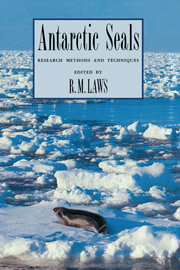Book contents
- Frontmatter
- Contents
- List of contributors
- Preface
- Introduction
- 1 Identification of species
- 2 Estimation of population sizes
- 3 Immobilization and capture
- 4 Marking techniques
- 5 Telemetry and electronic technology
- 6 Behaviour
- 7 Killing methods
- 8 Morphometrics, specimen collection and preservation
- 9 Genetic-based studies for stock separation
- 10 Collection of material for the determination of organochlorine and heavy metal levels
- 11 Age determination
- 12 Reproduction
- 13 Diet
- 14 Bioenergetics
- 15 Development of technology and research needs
- 16 Appendices
- Index
12 - Reproduction
Published online by Cambridge University Press: 05 February 2010
- Frontmatter
- Contents
- List of contributors
- Preface
- Introduction
- 1 Identification of species
- 2 Estimation of population sizes
- 3 Immobilization and capture
- 4 Marking techniques
- 5 Telemetry and electronic technology
- 6 Behaviour
- 7 Killing methods
- 8 Morphometrics, specimen collection and preservation
- 9 Genetic-based studies for stock separation
- 10 Collection of material for the determination of organochlorine and heavy metal levels
- 11 Age determination
- 12 Reproduction
- 13 Diet
- 14 Bioenergetics
- 15 Development of technology and research needs
- 16 Appendices
- Index
Summary
Introduction
An understanding of the salient features of the reproductive cycle in seals is of interest not only to the specialist, but also to workers in other fields, and for comparative purposes. The complex social behaviour shown by many seals is interpretable only in the light of the reproductive status of the animals concerned; an understanding of seal population dynamics can be reached only if the reproductive success of the members of the population is known; population changes can be monitored by observing changes in the mean age of puberty. These examples could be further enlarged, but the undoubted importance of the subject is attested by the large volume of work upon it. This chapter first provides an introduction to the reproductive cycle and the organs of reproduction which should enable newcomers to the field to find their way about and then describes some methods for studying foetal growth, estimating pregnancy rate and observations of birth and lactation. A method of establishing paternity particularly in relation to pups, by DNA fingerprinting is described. Puberty and sexual maturity are defined and a method described for calculating the mean age at sexual maturity. Finally, some additional field techniques and basic methods of analysis are described.
Although reproductive parameters have been established for some populations of certain species for a number of years it should be emphasized that there is considerable variation between populations or with latitude, and within unit populations there may be changes with time. Further studies are necessary.
The annual cycle
Antarctic seals show a very regular annual cycle imposed by the extreme seasonality of the polar environment.
- Type
- Chapter
- Information
- Antarctic SealsResearch Methods and Techniques, pp. 228 - 267Publisher: Cambridge University PressPrint publication year: 1993
- 8
- Cited by



